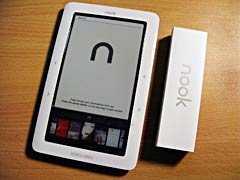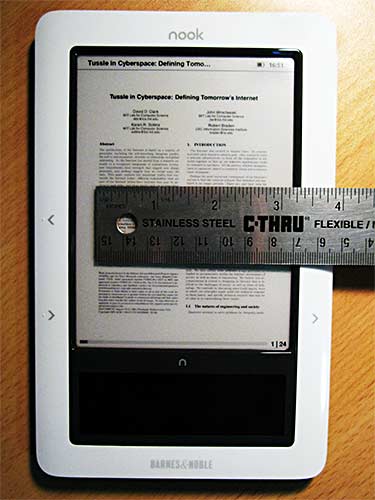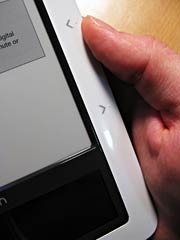A Nook of My Own
25 January 2010
12:47 AM
This past Christmas my future in-laws gave me a lovely gift, the nook, Barnes & Noble’s new electronic reader. I’ve decided to use the nook to conduct a semester long experiment, where I use it for as much of my reading as possible.
Even with the imminent arrival of the Apple Canvas, I’m excited about testing the nook for a few reasons. First, I’m hoping that reading on a reflective screen like the nook’s will be easier on my eyes. Every semester I have at least a few hundred pages of reading, nearly all of which is only available online. With the nook I have another alternative besides printing everything out or reading on my computer screen, which is hard on my eyes.
Second, I think that having a device just for reading will make it easier to stay focused on the task at hand (command-tab is my worst enemy). Some people think that single-purpose devices are too limited to become popular. For my money, I think they’re right—multipurpose devices will probably be more popular, but a smaller market doesn’t mean the nook (or Kindle) can’t be a commercial success.
While I’m testing the nook over the next few months I’ll write up my thoughts. Here’s my first batch.
Out of the Box

The nook arrives in an attractive clear plastic box that feels quite hefty. When I pulled off the cardboard cover from the box there was a message welcoming me to the nook. This was a nifty touch that actually tricked me: I thought the message was printed on a clear film that I would have to pull off the screen, but it was displayed on the screen itself. One of the advantages of the E Ink technology is that it remains on the screen indefinitely without consuming any power, so they display this message at the factory and it stays there until you see it. I had to fumble with the box for awhile to get it open and remove the nook. The packing is somewhat excessive, as indicated by the two pages of instructions on how to unpack your nook. If I need seven steps to get your product out of the box, you packed it wrong.
Free “Content” and Book Samples
Getting the nook up and running was painless. After charging the device for a few hours I created an account at Barnes & Noble and entered my username and password into the nook. Then I went looking for something to read.
As a grad student I’m not exactly swimming in a pool of gold coins, so the first place I landed was the selection of free ebooks that you can download from Barnes & Noble. After browsing through the available titles it’s pretty clear these books are free because no one in her right mind would pay for them. Here are some standouts in the lineup:
- RAVISHED: An Office FemDom Story by Joe Brewster
- Slow Hands (Harlequin Blaze Series #402) by Leslie Kelly
- I Will Be Your Dominatrix by Sarah Welcombe
- Parking Lot Hero by J.M. Snyder
- Love in the Library by J.M. Snyder
- Foreplay by J.M. Snyder
- Fuck the Foreplay by J.M. Snyder
- Las Vegas Weekend (part of Gigolo: The Series) by Marion Francis
- nudecelebspacevampire.jpg by Jules Wellesley
- Virginia - The Vampires Mistress by Marion Francis
Apparently this is the best Barnes & Noble can do in the free department: vampire romance short stories and gems about the city where “what happen’s in Vegas, Stay’s in Vegas [sic].” Instead of offering disposable books, why not offer, say, the top 10 books of 2009 for free? The cost to Barnes & Noble should be minimal given their role as a distributor. Even if it isn’t, this is the sort of thing that would create an out-of-the-box experience that people would rave about. To their credit, Barnes & Noble preloads the nook with three more durable books: Dracula, Little Women, and Price and Prejudice.
Barnes & Noble says they let you download free samples of any book in their online store to decide if you want to buy it. This is a nice analogue to thumbing through the book in the store before you take it to the cash register. I downloaded the free sample of Michael Pollan’s The Omnivore’s Dilemma. The first 28 pages (which are shorter than a ordinary book page) were the cover, copyright page, table of contents, acknowledgment, and excerpts of reviews from critics. Pollan’s introduction finally began on page 29 and it continued to page 33 where it ended unceremoniously mid-sentence. I fared better with a sample of Dan Brown’s The Lost Symbol, which was 114 pages long, although I still had to flip through the first 20 pages before I got to the preface.
Academic Papers on the Nook
Eventually I’ll buy a book and read through it on the nook, but one of the main reasons I’m interested in the device is to read papers for my courses. This week I had to read the classic “Tussle in Cyberspace” again, so I downloaded the PDF and simply copied it to the nook’s internal storage. When I selected the paper from the “My Documents” menu there was a small problem:

PDFs have a fixed size, and the double-column format common to research papers doesn’t fare well when shrunk, although this might be a viable option on the pricy Kindle DX or pricier still QUE (what is it with Barnes & Noble and strange capitalization?).
The solution is to convert your PDF into an eBook format that supports reflowing, adjusting the size and placement of the words to a specific device’s screen. I used calibre to convert my PDF to an ePub file, and then uploaded that to my nook. Calibre correctly converted the multicolumn PDF, which was a problem for a web-based conversion tool that I tried. Without much trouble I was able to copy the converted version to the nook. After this, I had mostly what I wanted. There are still some glitches in the reflowing process, however, which leave unsightly gaps and unnecessary hyphenation caused by line breaks in the original PDF. I think I can get better results if I do some tweaking.
Button Placement
The only remaining comment I have about the nook is that I think the paging buttons should be reversed. On either side of the nook there are large buttons that page the book you’re reading forward or backward. When I hold the nook firmly in my hands, I find that my thumb is directly above the back button. Maybe they did user testing and found that the actual placement is better for more people, but for me it feels wrong. The top row should be flipped with the bottom row.
Closing Thoughts
Despite the rough edges in the conversion process, I’m looking forward to doing my reading on the nook for the next few months. If I find a good workflow for converting PDFs, I’ll write a walkthrough of the process and share it. In the meantime, I’ll be curled up reading a copy of nudecelebspacevampire.jpg…or something like that.


Comments